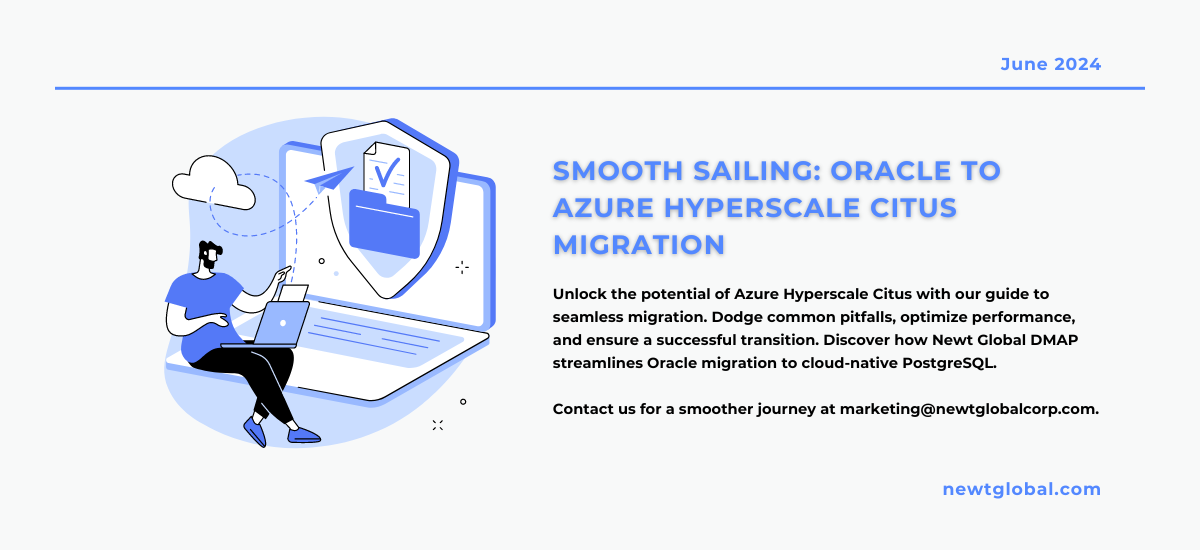
Thinking about moving your database from Oracle to Azure Hyperscale Citus? This change can offer a lot of benefits like better scalability, improved performance, and saving money. But, this move needs careful planning and thought to avoid any problems. This guide will help you understand the key issues to avoid when moving from Oracle to Azure Hyperscale Citus, ensuring a smooth change to a more efficient and scalable database.
Understanding the Complexity of Changing the Database Layout
-
- Deep Dive Before Moving: Before you move, take a close look at your current Oracle database layout. Know your tables, views, sequences, and more. This preparation makes changing the layout easier.
- Ask for Expert Advice: It might be a good idea to talk to experts in Azure migrations or use professional services. Their knowledge can help you through the tricky parts of changing the layout and avoid common mistakes.
Forgetting About Oracle’s Special Features
-
- Matching Features: Make a detailed list of Oracle-only features and find their equivalents in Azure Hyperscale Citus or other solutions. This list will guide you through the migration.
- Custom Solutions: If some features don’t have a direct match, think about creating custom solutions or using third-party tools to fill those gaps.
Not Optimizing Indexes
-
- Test Performance: Do thorough performance tests to figure out which indexes are most beneficial in the new environment. Look at different types of queries and workloads.
- Manage Indexes Well: Plan how you’ll handle indexes across different parts of your database, like splitting data and balancing loads.
Ignoring Data Compatibility
-
- Check Your Data: Use a strong data check system to find and fix any issues with data types and characters during the move.
- Follow Encoding Standards: Stick to international standards for encoding to handle characters correctly and prevent data issues.
Failing to Plan for Distributed Data
-
- Sharding Key Selection: Pick sharding keys wisely to match how you’ll query the data, ensuring efficient distribution and access.
- Data Redistribution Plan: Make a plan for moving data around regularly. This keeps things running smoothly and avoids slow spots.
Missing Transaction Changes
-
- Adjust for Concurrency: Change how you control concurrent operations to fit Azure Hyperscale Citus’s way of doing things, keeping transactions accurate without losing performance.
- Rework Transactions: Change your transactional processes to make the most of distributed transactions and avoid slowdowns.
Skipping Tests and Checks
-
- Automated Testing: Use automated testing to check everything, catching any issues early.
- Load and Stress Testing: Test how well your setup handles lots of users. This shows if it can handle big loads without crashing.
Underestimating the Need for Performance Tuning
-
- Keep Checking: Watch how your system works over time. Look for slow parts and make them faster.
- Adapt Queries: Use adaptive techniques and tools to keep improving how queries perform as the amount and type of data change.
Not Preparing for Maintenance and Monitoring Changes
-
- Guides for Operations: Write detailed guides for the new maintenance and monitoring tasks specific to Azure Hyperscale Citus.
- Use Automation: Use automation for regular tasks to reduce manual work and the chance of mistakes.
Not Training Your Team
-
- Tailored Training: Create training that’s specific to the new features and best practices of Azure Hyperscale Citus for your team.
- Practical Workshops: Organize workshops and practice sessions so your team can get hands-on experience with the new system.
Conclusion
Moving from Oracle to Azure Hyperscale Citus is a big step that can make your database more scalable and efficient. But, success depends on careful planning, being aware of and avoiding common problems, and committing to detailed testing and improvements. By avoiding these mistakes, you can have a smooth change and fully benefit from your new database setup. Remember, it’s all about preparing well for this journey to make it successful.
To embark on a successful migration journey from Oracle to Azure Hyperscale Citus, it’s crucial to navigate carefully and avoid common pitfalls. At Newt Global, we understand the complexities involved and are committed to guiding you through this transition seamlessly.
Are you ready to unleash the full potential of your database environment?
Let us help you navigate the migration journey with expertise and precision. Contact us today at marketing@newtglobalcorp.com to learn how Newt Global DMAP, our world-class product, can facilitate the mass migration of your Oracle database to cloud-native PostgreSQL
Remember, meticulous planning and attention to detail are the keys to a successful migration. Don’t let pitfalls derail your progress. Reach out to us and embark on your migration journey with confidence.
Newt Global DMAP is a world-class product enabling mass migration of Oracle Db to cloud-native PostgreSQL faster, better, and cheaper.
